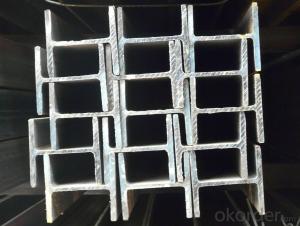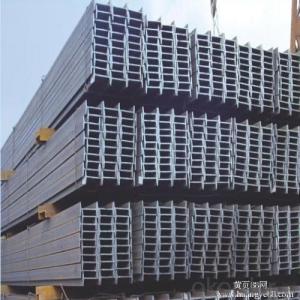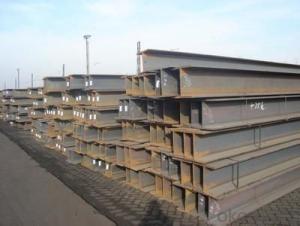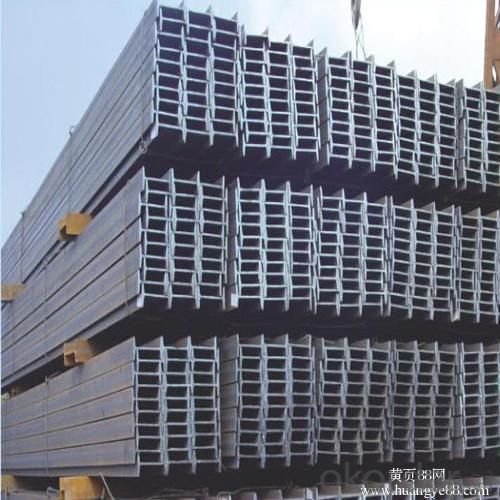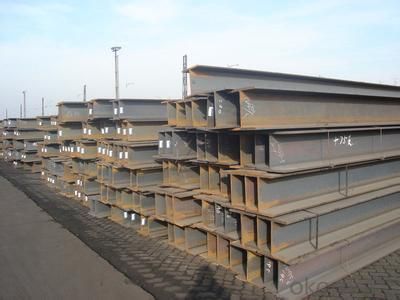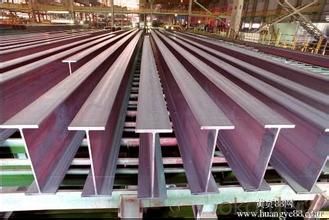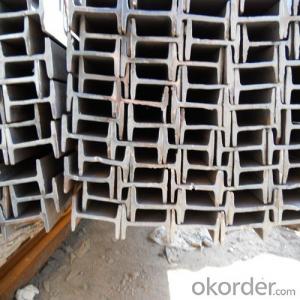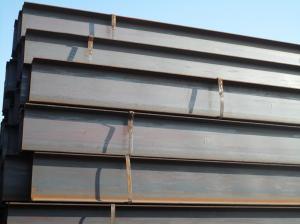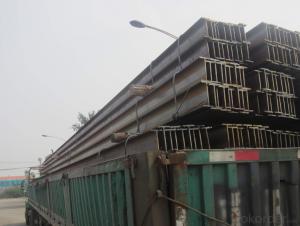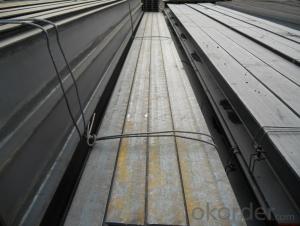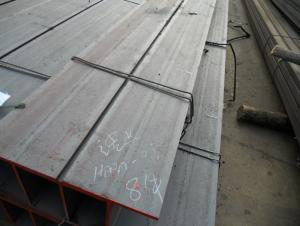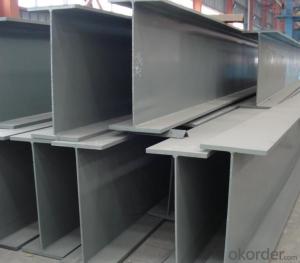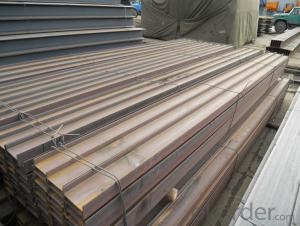Hot Rolled H-Beam Steel JIS G3101
- Loading Port:
- China Main Port
- Payment Terms:
- TT or LC
- Min Order Qty:
- -
- Supply Capability:
- -
OKorder Service Pledge
OKorder Financial Service
You Might Also Like
Product Description:
OKorder is offering Hot Rolled H-Beam Steel JIS G3101 at great prices with worldwide shipping. Our supplier is a world-class manufacturer of steel, with our products utilized the world over. OKorder annually supplies products to European, North American and Asian markets. We provide quotations within 24 hours of receiving an inquiry and guarantee competitive prices.
Product Applications:
Hot Rolled H-Beam Steel JIS G3101 are ideal for structural applications and are widely used in the construction of buildings and bridges, and the manufacturing, petrochemical, and transportation industries.
Product Advantages:
Hot Rolled H-Beam Steel JIS G3101 with high quality are durable, strong, and resist corrosion.
Main Product Features:
· Premium quality
· Prompt delivery & seaworthy packing (30 days after receiving deposit)
· Corrosion resistance
· Professional Service
· Competitive pricing
Product Specifications:
1. Standard: JIS G3101
2. Grade: SS400 or Equivalent
3. Length: 6m,10m, 12m as following table
4. Invoicing on theoretical weight or actual weight as customer request
5.Payment: TT or L/C
6. Sizes:
SIZE(mm) | DIMENSION(kg/m) |
100*100 | 16.9 |
125*125 | 23.6 |
150*75 | 14 |
150*150 | 31.1 |
148*100 | 20.7 |
198*99 | 17.8 |
200*100 | 20.9 |
248*124 | 25.1 |
250*125 | 29 |
300*150 | 36.7 |
298*149 | 32 |
200*200 | 49.9 |
294*200 | 55.8 |
346*174 | 41.2 |
350*175 | 49.4 |
244*175 | 43.6 |
175*175 | 40.4 |
294*200 | 55.8 |
298*201 | 64.4 |
346*174 | 41.2 |
350*175 | 49.4 |
400*200 | 65.4 |
396*199 | 56.1 |
450*200 | 74.9 |
446*199 | 65.1 |
340*250 | 78.1 |
500*200 | 88.1 |
300*150 | 36.7 |
Commercial building structure ;Pre-engineered buildings; Machinery support structure; Prefabricated structure; Medium scale bridges; Ship-building structure. etc.
Packaging & Delivery of Hot Rolled H-Beam Steel
1. Packing: it is nude packed in bundles by steel wire rod
2. Bundle weight: not more than 3.5MT for bulk vessel; less than 3 MT for container load
3. Marks:
Color marking: There will be color marking on both end of the bundle for the cargo delivered by bulk vessel. That makes it easily to distinguish at the destination port.
Tag mark: there will be tag mark tied up on the bundles. The information usually including supplier logo and name, product name, made in China, shipping marks and other information request by the customer.
If loading by container the marking is not needed, but we will prepare it as customer request.
4. Transportation: the goods are delivered by truck from mill to loading port, the maximum quantity can be loaded is around 40MTs by each truck. If the order quantity cannot reach the full truck loaded, the transportation cost per ton will be little higher than full load.
5. Delivered by container or bulk vessel
Production flow of Hot Rolled H-Beam Steel
Material prepare (billet) —heat up—rough rolling—precision rolling—cooling—packing—storage and transportation
FAQ:
Q1: Why buy Materials & Equipment from OKorder.com?
A1: All products offered byOKorder.com are carefully selected from China's most reliable manufacturing enterprises. Through its ISO certifications, OKorder.com adheres to the highest standards and a commitment to supply chain safety and customer satisfaction.
Q2: Can fit in the containers of 20fts the steel beams of 6M?
A2: No proble, we can put them into the containers in the form sideling.
Q3: The products are invoicing on theoritical weight or on actual weight?
A3: We can do it in both manners, according to the customers' request.
Images:
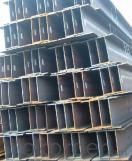

- Q: How do steel H-beams perform in structures with uneven load distribution?
- Steel H-beams perform well in structures with uneven load distribution due to their excellent load-bearing capacity and structural integrity. The H shape provides stability and resistance against bending and twisting forces, ensuring even load distribution across the beam. Moreover, the high strength and rigidity of steel make it capable of handling varying loads without compromising the structural integrity of the overall structure.
- Q: Are steel H-beams compatible with different types of roofing materials?
- Different types of roofing materials can be used with steel H-beams. When it comes to construction, steel H-beams are commonly employed to offer structural support for roofs and other load-bearing purposes. These beams are designed to be adaptable, accommodating a wide variety of roofing materials such as metal, asphalt shingles, clay tiles, slate, and concrete. The strength and durability of steel H-beams make them appropriate for supporting the weight of various roofing materials, ensuring a stable and secure structure. Furthermore, steel H-beams are easily customized and adjusted to fit different roof designs and configurations, giving flexibility in choosing the most suitable roofing material for a specific project. In summary, steel H-beams provide a reliable and compatible option for supporting different types of roofing materials in construction.
- Q: Can steel H-beams be used for supporting mining infrastructure?
- Steel H-beams prove to be a valuable solution for supporting mining infrastructure. Their strength and versatility make them a common choice in construction and civil engineering projects. These beams are specifically designed to withstand heavy loads and provide structural support, which makes them highly suitable for mining infrastructure. In the mining industry, the stability and safety of underground tunnels, shafts, and other mining structures are of utmost importance. This requires robust support systems. Steel H-beams are well-suited for this purpose as they possess a high load-bearing capacity and resistance to bending. These qualities enable them to endure the challenging conditions commonly found in mining environments. Moreover, steel H-beams offer customization options to cater to specific project requirements. They can be easily cut into various lengths and welded together to create larger structural elements. This enables the construction of complex support systems tailored to the unique needs of mining infrastructure. Furthermore, steel H-beams are known for their durability and long lifespan. This reduces the frequency of maintenance or replacement, which is significant in the mining industry. Minimizing downtime and maintenance costs is crucial to maintain productivity and profitability. In conclusion, steel H-beams are an excellent choice for supporting mining infrastructure due to their strength, versatility, and durability. Their ability to provide the necessary support and stability in mining environments makes them an ideal option for constructing and reinforcing underground mining structures.
- Q: How do steel H-beams contribute to the overall safety of a structure?
- Steel H-beams contribute to the overall safety of a structure in several significant ways. Firstly, the H-beam's unique shape and design provide superior structural strength and load-bearing capabilities. The horizontal flanges and vertical web of the H-beam create a strong and rigid framework that can withstand heavy loads, such as those from the weight of the building itself or external forces like wind or earthquakes. This ensures the structural integrity of the building and reduces the risk of collapse. Additionally, steel H-beams are manufactured using high-quality steel, which offers exceptional strength and durability. Steel is known for its ability to resist deformation and maintain its shape even under extreme conditions. This property makes H-beams capable of withstanding various stresses and strains that can occur in a structure, such as bending, twisting, or shearing forces. By preventing any significant deformations, steel H-beams help maintain the stability and safety of the entire structure. Moreover, steel is a non-combustible material, making H-beams highly resistant to fire. In the event of a fire, the steel H-beams will not contribute to the spread or intensity of the flames, providing valuable fire protection and containment. This fire resistance property enhances the overall safety of the structure and allows for more time for evacuation and firefighting efforts. Furthermore, steel H-beams are typically used to construct the primary load-bearing elements, such as columns, beams, and frames, in a building's structural system. By using H-beams, the weight distribution is more evenly spread throughout the structure, reducing the likelihood of localized stress concentrations. This even distribution of loads minimizes the risk of structural failure and enhances the overall safety of the building. Lastly, steel H-beams are highly versatile and can be customized to meet specific design requirements. This flexibility allows engineers to optimize the structural design for safety and efficiency, ensuring that the H-beams are appropriately sized, spaced, and connected to withstand the anticipated loads and possible hazards. In conclusion, the use of steel H-beams in construction significantly contributes to the overall safety of a structure. Their superior strength, durability, fire resistance, even load distribution, and customization options all play a crucial role in enhancing the structural integrity and protecting the occupants from potential risks and hazards.
- Q: Can steel H-beams be used for supporting roller coasters or amusement park rides?
- Yes, steel H-beams can be used for supporting roller coasters or amusement park rides. Steel H-beams are commonly used in construction due to their strength, durability, and ability to bear heavy loads. Roller coasters and amusement park rides require sturdy support structures, and steel H-beams provide the necessary strength and stability to ensure the safety and stability of these attractions.
- Q: Can Steel H-Beams be used in historical or heritage restoration projects?
- Yes, Steel H-Beams can be used in historical or heritage restoration projects depending on the specific requirements and circumstances. While traditional building materials are often preferred for historical restoration, steel H-Beams can offer structural support, durability, and flexibility, particularly when it comes to reinforcing or replacing damaged elements. However, their use must be done carefully and in consultation with experts to ensure compatibility with the existing structure and adherence to preservation guidelines.
- Q: What are the typical uses of steel H-beams in construction projects?
- Steel H-beams find widespread use in construction projects for a multitude of purposes. Among these, they are commonly employed as a means of structural support in both buildings and bridges. The design of these beams allows them to withstand substantial loads, thereby ensuring the stability of the structure. Within the realm of building construction, steel H-beams fulfill the roles of both columns and beams, enabling them to bear the weight of the building and distribute the load evenly. Consequently, they are frequently employed in the construction of high-rise buildings, industrial structures, and warehouses. Additionally, they play a crucial role in the construction of bridges, providing the necessary strength and stability to support the bridge's weight and the traffic traversing it. Another typical application of steel H-beams lies in the construction of mezzanine floors. These intermediate floors are introduced within a building to generate additional usable space. As the primary support structure for these floors, H-beams deliver the requisite strength and stability. Furthermore, steel H-beams are frequently employed in the construction of platforms, walkways, and staircases. Their robust and dependable structure ensures the safety of individuals utilizing these elements. In sum, steel H-beams are indispensable components in construction projects, delivering structural support, stability, and strength. Their adaptability and resilience render them a favored choice in a wide range of construction applications.
- Q: What are the safety considerations for steel H-beams in construction?
- Some of the safety considerations for steel H-beams in construction include proper handling and installation techniques, ensuring structural integrity, and adherence to load capacity guidelines. It is crucial to follow safety protocols during lifting, positioning, and connecting the beams to prevent accidents or structural failures. Regular inspections and maintenance are also necessary to identify any signs of damage or deterioration that could compromise the beams' safety.
- Q: How do steel H-beams perform in termite-infested areas?
- Steel H-beams are highly resistant to termites and perform exceptionally well in termite-infested areas. Unlike wooden beams, steel does not provide a food source for termites, preventing any structural damage caused by these pests. Therefore, steel H-beams are a reliable and durable choice for construction projects in termite-prone regions.
- Q: Are steel H-beams suitable for power plants?
- Yes, steel H-beams are often suitable for power plants due to their strength and durability. Power plants typically require large and robust structures to support heavy equipment and withstand extreme conditions. Steel H-beams are known for their high load-bearing capacity and resistance to bending, making them a popular choice for power plant construction. H-beams are designed to distribute weight evenly and efficiently, allowing them to support heavy machinery and equipment found in power plants, such as generators, boilers, and turbines. Their shape, with a wider flange and a thinner web, provides excellent stability and structural integrity, making them suitable for withstanding the dynamic loads and vibrations common in power plant operations. Additionally, steel H-beams can be fabricated to meet specific design requirements and can be easily assembled, allowing for quick and efficient construction. This is crucial for power plants, as they often have strict deadlines and need to be operational as soon as possible. Furthermore, steel H-beams have excellent resistance to corrosion, which is essential in a power plant environment where exposure to moisture, chemicals, and high temperatures is common. This ensures the longevity and reliability of the structural components. In summary, steel H-beams are suitable for power plants due to their strength, load-bearing capacity, stability, and resistance to corrosion. Their ability to support heavy equipment, withstand extreme conditions, and provide efficient construction makes them a preferred choice for power plant construction projects.
Send your message to us
Hot Rolled H-Beam Steel JIS G3101
- Loading Port:
- China Main Port
- Payment Terms:
- TT or LC
- Min Order Qty:
- -
- Supply Capability:
- -
OKorder Service Pledge
OKorder Financial Service
Similar products
Hot products
Hot Searches
Related keywords

